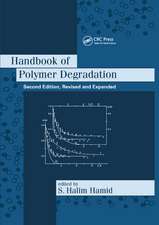Polymer Carbon Nanotube Composites: The Polymer Latex Concept
Editat de Cor Koning, Marie-Claire Hermant, Nadia Grossiorden Limba Engleză Hardback – 11 apr 2012
Preț: 892.92 lei
Preț vechi: 1088.92 lei
-18% Nou
Puncte Express: 1339
Preț estimativ în valută:
170.88€ • 178.18$ • 142.02£
170.88€ • 178.18$ • 142.02£
Carte tipărită la comandă
Livrare economică 20 martie-03 aprilie
Preluare comenzi: 021 569.72.76
Specificații
ISBN-13: 9789814310932
ISBN-10: 981431093X
Pagini: 256
Ilustrații: 96 b/w images
Dimensiuni: 152 x 229 mm
Greutate: 0.5 kg
Ediția:1
Editura: Jenny Stanford Publishing
Colecția Jenny Stanford Publishing
ISBN-10: 981431093X
Pagini: 256
Ilustrații: 96 b/w images
Dimensiuni: 152 x 229 mm
Greutate: 0.5 kg
Ediția:1
Editura: Jenny Stanford Publishing
Colecția Jenny Stanford Publishing
Public țintă
Academic and PostgraduateRecenzii
"These authors are leading researchers and have done a great service to the community by capturing the current understanding of carbon nanotube polymer nanocomposites. Active research in industry and academia alike will find this book a timely and valuable resource, particularly as it pertains to electrical conductivity of these fascinating materials."
—Prof. Karen I. Winey - University of Pennsylvania, USA
"Carbon nanotubes are promising conductive fillers for a variety of applications from organic electronics to electrostatic dissipation of composites. This book provides a valuable review on the processing of nanotube dispersions and composites. An emphasis is given to the "latex technology", one of the most efficient approaches to achieve conductive networks of nanotubes. This book will be of great interest to a broad readership in chemistry, physics and materials science in both academia and industry."
—Dr. Philippe Poulin - Centre de Recherche Paul Pascal, France
—Prof. Karen I. Winey - University of Pennsylvania, USA
"Carbon nanotubes are promising conductive fillers for a variety of applications from organic electronics to electrostatic dissipation of composites. This book provides a valuable review on the processing of nanotube dispersions and composites. An emphasis is given to the "latex technology", one of the most efficient approaches to achieve conductive networks of nanotubes. This book will be of great interest to a broad readership in chemistry, physics and materials science in both academia and industry."
—Dr. Philippe Poulin - Centre de Recherche Paul Pascal, France
Cuprins
Introduction
Composite Materials
Altered Behavior of Nano-Fillers
Carbon Nanotubes and Composites Thereof
Percolation Theory for Rods
Scope of This Book
Toolbox for Dispersing Carbon Nanotubes into Polymers to Get Electrically Conductive Nanocomposites
General Introduction
Incorporation of CNTs into a Polymer Matrix: A Challenge
Ultrasound
CNT Purification
Methods to Disperse Individual CNTs in a Polymer Matrix
Conclusions
Tailoring and Monitoring the Sonication-Driven Dispersion of Carbon Nanotubes in Aqueous Surfactant Solutions
Introduction
Characterization of the Bundling of CNT Aqueous Dispersions in General; Monitoring of the Debundling Process in Particular: A Short Overview of Suitable Characterization Techniques
Optimization of the CNT Debundling Parameters to Make Conductive CNT/Polymer Nanocomposites with UV-Vis Spectroscopy
Food for Thought: A Critic of Purification of SWCNTs
Centrifugation of Aqueous Surfactant-CNT Dispersions
Conclusions
Aspects of Processing Methods and Conditions Affecting Percolation Networks
Segregated Networks and Dynamic Percolation
The Role of the Matrix Viscosity: Molecular Weight Distributions and Processing Temperatures
Processing Techniques and Percolation Thresholds
Conclusions
On the Versatility of the Latex-Based Process Regarding the Choice of the Polymer Matrix of the Nanocomposite
Introduction
Semi-Crystalline Polypropylene Matrix
Polymer Blends
Conclusions
Manipulating the Percolation of CNTs Using Hybrid Composite Systems
Introduction
Eliminating Non-Contact Resistivity
General Conclusions
Future Perspectives
Introduction: Toward Large-Scale Production
Food for Thought: Possible Applications of CNT/Polymer Composites?
What’s Next?
Index
Composite Materials
Altered Behavior of Nano-Fillers
Carbon Nanotubes and Composites Thereof
Percolation Theory for Rods
Scope of This Book
Toolbox for Dispersing Carbon Nanotubes into Polymers to Get Electrically Conductive Nanocomposites
General Introduction
Incorporation of CNTs into a Polymer Matrix: A Challenge
Ultrasound
CNT Purification
Methods to Disperse Individual CNTs in a Polymer Matrix
Conclusions
Tailoring and Monitoring the Sonication-Driven Dispersion of Carbon Nanotubes in Aqueous Surfactant Solutions
Introduction
Characterization of the Bundling of CNT Aqueous Dispersions in General; Monitoring of the Debundling Process in Particular: A Short Overview of Suitable Characterization Techniques
Optimization of the CNT Debundling Parameters to Make Conductive CNT/Polymer Nanocomposites with UV-Vis Spectroscopy
Food for Thought: A Critic of Purification of SWCNTs
Centrifugation of Aqueous Surfactant-CNT Dispersions
Conclusions
Aspects of Processing Methods and Conditions Affecting Percolation Networks
Segregated Networks and Dynamic Percolation
The Role of the Matrix Viscosity: Molecular Weight Distributions and Processing Temperatures
Processing Techniques and Percolation Thresholds
Conclusions
On the Versatility of the Latex-Based Process Regarding the Choice of the Polymer Matrix of the Nanocomposite
Introduction
Semi-Crystalline Polypropylene Matrix
Polymer Blends
Conclusions
Manipulating the Percolation of CNTs Using Hybrid Composite Systems
Introduction
Eliminating Non-Contact Resistivity
General Conclusions
Future Perspectives
Introduction: Toward Large-Scale Production
Food for Thought: Possible Applications of CNT/Polymer Composites?
What’s Next?
Index
Notă biografică
Cor Koning, Marie-Claire Hermant, Nadia Grossiord
Descriere
This book provides readers with a comprehensive toolbox for dispersing single-walled and multiwalled carbon nanotubes in thermoplastic polymer matrices. The book starts with an overview of all known techniques for dispersing CNTs in thermoplastic polymers and then concentrates on one of the most versatile techniques known nowadays: the so-called latex technology. Also discussed are the basic principles of this latex technology, the role of the matrix viscosity on percolation threshold, the importance of the intrinsic CNT quality, the use of "smart" surfactants facilitating electron transport in the final composite, the preparation of highly loaded master-batches, which can be diluted with virgin polymer by melt-extrusion, and some promising potential applications.























